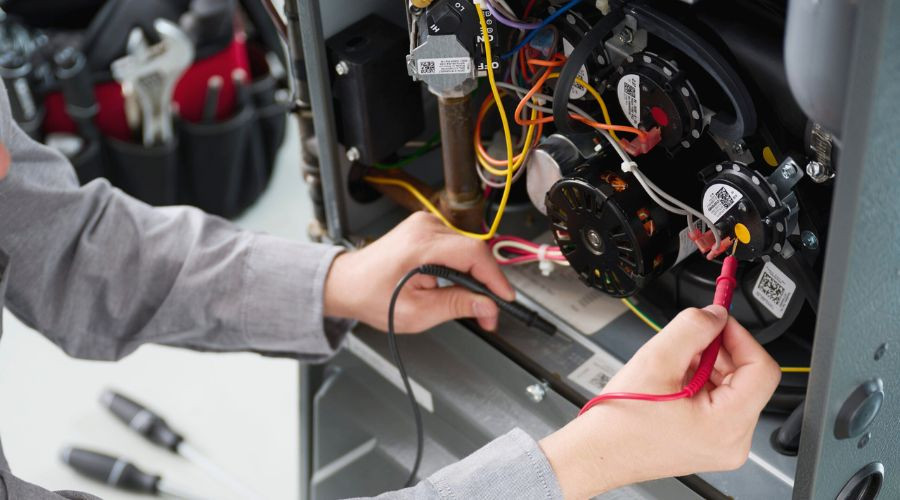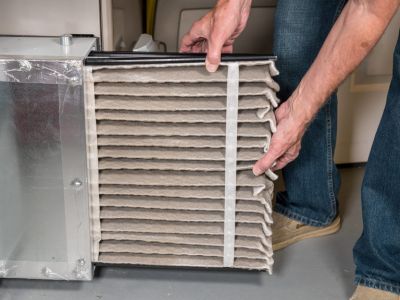
Identifying the Signs
Heating systems are supposed to heat the whole home without overheating. Since many homeowners can’t feel when their heater is overworked, a few common signs indicate trouble. A dangerous heating system can cause house fires and carbon monoxide poisoning, so knowing the basics is crucial.
How To Tell if There Is a Carbon Monoxide Leak
Carbon monoxide is an odorless, colorless, toxic gas that happens when the furnace is broken. Since it is virtually undetectable, most homeowners have carbon monoxide detectors.
A carbon monoxide detector has a small microchip built into a chamber that houses the gas sensor. This measures the concentration of carbon monoxide in the air via parts per million. When carbon monoxide is present, the detector will sound a loud alarm to warn all household members of the problem.
There are a few reasons why carbon monoxide leaks occur. The most common problem lies within the heat exchanger. If the heat exchanger is cracked, fumes circulate throughout the home. Carbon monoxide poisoning can happen in hours or days, depending on how big the crack is. All household members must leave the house right away.
Signs of a carbon monoxide leak can be physically detected. Carbon monoxide poisoning leads to headaches, dizziness, nausea, confusion, blurred vision, and even shortness of breath. If carbon monoxide goes unnoticed, it can also lead to death.
Moldy Heaters
 A moldy heater will create health hazards for anyone inside the home. This includes children, pets, and long-term guests. No matter the outdoor humidity, mold is not a natural part of the healing process and should be removed immediately.
A moldy heater will create health hazards for anyone inside the home. This includes children, pets, and long-term guests. No matter the outdoor humidity, mold is not a natural part of the healing process and should be removed immediately.
Mold tends to grow in moist environments. This means the air ducts are a perfect spot for spores to thrive. Heating systems that have little ventilation are at risk of developing condensation and excess moisture that eventually causes toxic mold.
It can be difficult to see mold if it is trapped inside the heating system. Indications of indoor mold include unusual musty smells. A mildewy scent that can be smelled anywhere in the home is usually a sign of trapped moisture. Household members may experience skin rashes, allergies, and even respiratory issues if it is not removed.
Overheating Furnaces
 If the HVAC system overheats, it can cause furnace fires, carbon monoxide poisoning, and damage to the heater. Luckily, sometimes overheating can be prevented by homeowners.
If the HVAC system overheats, it can cause furnace fires, carbon monoxide poisoning, and damage to the heater. Luckily, sometimes overheating can be prevented by homeowners.
Closed vents cause problems with the household temperature. If more than one or two vents are closed, homeowners are advised to turn down the thermostat before opening them. This type of issue blocks airflow and can be dangerous.
Another way homeowners can prevent this problem is by regularly changing their air filters. After three months, furnace filters become coated with dust particles and lint. Once the airflow is restricted, the furnace must work twice as hard to achieve the desired temperature.
Furnace overheating produces a smokey smell. Sometimes, this is because of an actual fire. Humming noises can predict fires and should never be ignored, even with low volume. To stay safe throughout the winter, annual heating maintenance is recommended. Heating repair services are less expensive if the problem is fixed early.
About Chad’s AC Direct
Chad’s AC Direct provides trustworthy service in Montgomery, AL, with an itemized list of parts so customers know they are getting the best deal. They always arrive on time, offer honest advice, and work to find a well-budgeted solution. To learn more about their financing options or to schedule a heating service, call Chad’s AC Direct today.
Distribution Links +
- htv10.tv
- wicz.com
- snntv.com
- central.newschannelnebraska.com
- metro.newschannelnebraska.com
- southeast.newschannelnebraska.com
- northeast.newschannelnebraska.com
- plattevalley.newschannelnebraska.com
- panhandle.newschannelnebraska.com
- rivercountry.newschannelnebraska.com
- wpgxfox28.com
- lifestyle.mykmlk.com
- wtnzfox43.com
- lifestyle.3wzfm.com
- lifestyle.southernsportstoday.com
- lifestyle.thepodcastpark.com
- lifestyle.680thefan.com
- lifestyle.xtra1063.com
- lifestyle.953hlf.com
- lifestyle.rewind1019.com
- lifestyle.us983.com
- lifestyle.countrylegends1059.com
- lifestyle.967wshv.com
- lifestyle.1045thedan.com
- michigan.yournewsnet.com
- lifestyle.earl983.com
- lifestyle.maverick1023.com
- lifestyle.magic979wtrg.com
- lifestyle.1077lakefm.com
- https://smb.natchezdemocrat.com
- https://smb.orangeleader.com
- https://smb.panews.com
- https://smb.picayuneitem.com
- https://smb.southwestdailynews.com
- https://smb.alabamanow.com
- https://smb.albertleatribune.com
- https://smb.andalusiastarnews.com
- https://smb.lobservateur.com
- https://smb.panolian.com
- https://smb.alexcityoutlook.com
- https://smb.americustimesrecorder.com
- https://smb.atmoreadvance.com
- https://smb.amnews.com
- https://smb.austindailyherald.com
- https://smb.americanpress.com
- https://smb.dailyleader.com
- https://smb.oxfordeagle.com
- https://smb.vicksburgpost.com
- https://smb.bluegrasslive.com
- https://smb.claiborneprogress.net
- https://smb.clantonadvertiser.com
- https://smb.brewtonstandard.com
- https://smb.demopolistimes.com
- https://smb.elizabethton.com
- https://smb.greenvilleadvocate.com
- https://smb.jessaminejournal.com
- https://smb.kenbridgevictoriadispatch.com
- https://smb.leaderpub.com
- https://smb.luvernejournal.com
- https://smb.selmatimesjournal.com
- https://smb.thesnaponline.com
- https://smb.troymessenger.com





